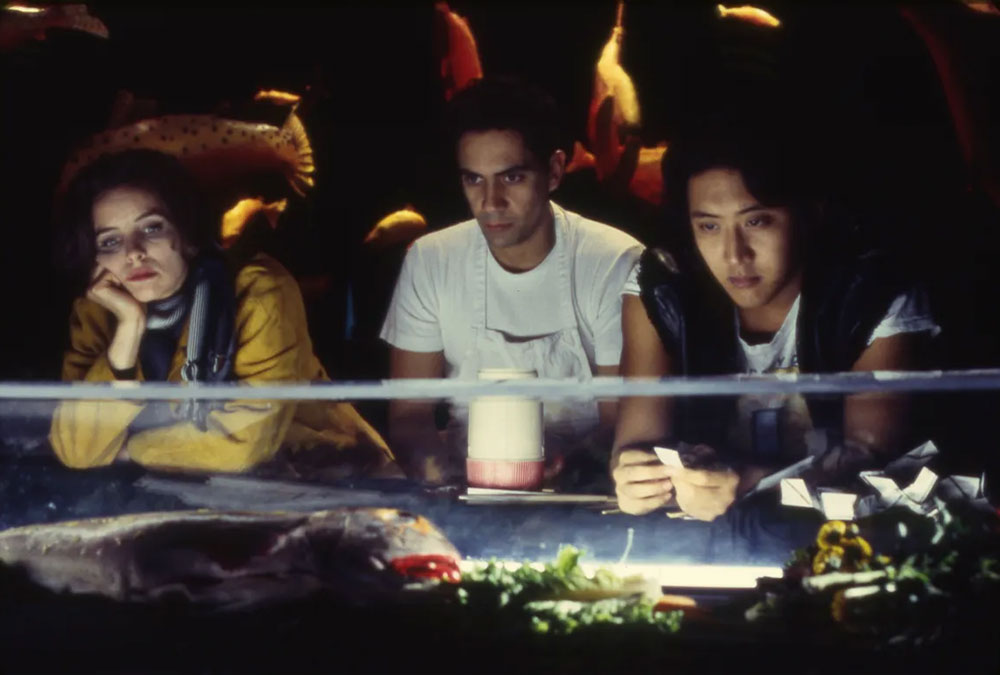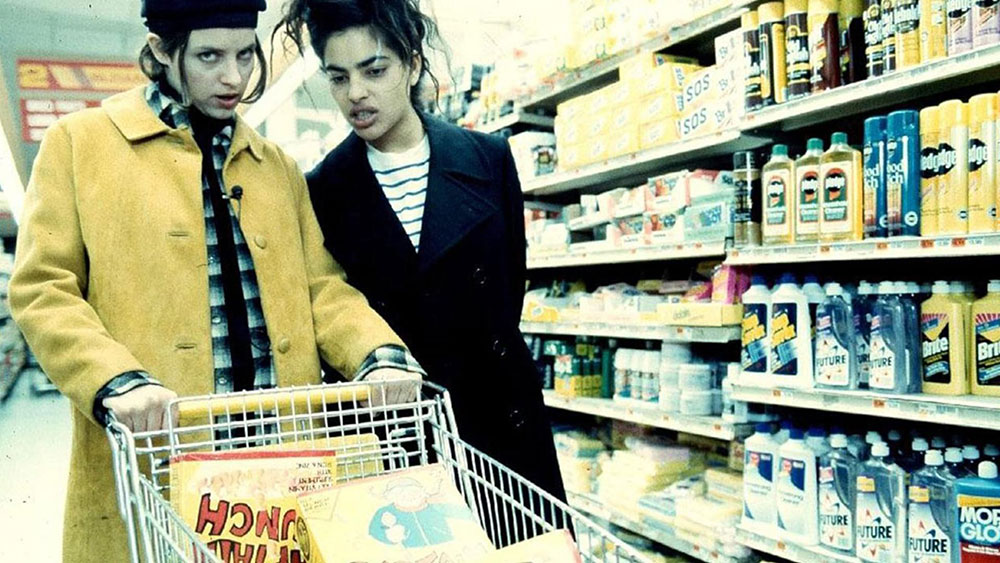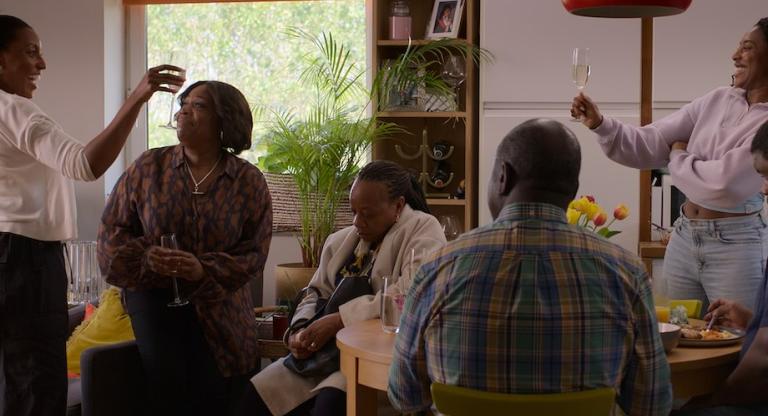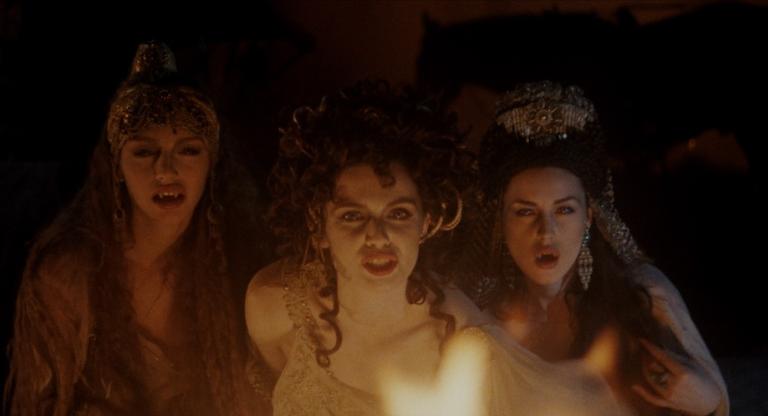Stylized after the quick edits associated with 1990s television, Fresh Kill (1994) is a film bursting at the seams with information, plot, characters, and political commentary. The feature film debut by artist Shu Lea Cheang celebrates its 30th anniversary this year with a new 35mm print. The cornucopia of social issues in Fresh Kill are presented as earnt and as truncated as advert. One minute you are watching a harrowing report on war and environmental racism, the next minute you receive an advert for dildos designed to give maximum pleasure. The whiplash effect associated with those juxtapositions is the point and you enter sensory overload. It is only then, when your mind breaks, that you are reminded of your body; it’s a fleshy, sticky, wet, and aging container that needs food, water, rest, and sometimes sex to sustain itself.
Sex, politics, and technology are major throughlines across the work of Cheang, whose work I first encountered when I wrote my master’s thesis a decade ago about her cyber punk/porn film I.K.U. (2000). While Cheang’s singular aesthetic style of “cybernoia” still stands out in Fresh Kill, it is her ability to seamlessly integrate the politics of race, gender, sexuality, and class into the film in a way that does not overburden the narrative that is most impressive. In her films, identity informs and helps constitute the healthy political lives of her characters and it is not an essentialist position for any one character. Thirty years on, intimacy has been delinked from major accounts of political organizing, which has made the latter less communal and caring. Fresh Kill still feels revelatory in this respect, for it conveys a model of how strong the bonds of political kinship could be if intimacy were back on the table.
Ayanna Dozier: I've been familiar with your work for some time and I admire how you both utilize and visualize sex onscreen through the prism of political resistance and utopic futurisms. I think your body of work allows us to see how sexuality and technology can be realized across utopic possibilities of emancipation as opposed to the surveillance state that currently governs that relationship today.
This leads me to the current restoration print of Fresh Kill that is now playing in honor of its 30th anniversary. It is a film that navigates how ecological racism, gentrification, and tourism operate as extensions of imperialism. Additionally, Fresh Kill navigates how technology can be used as a tool for disruption, all while never losing sight of its characters’ sexualities and sexual expression. Sexuality and identity in this film is not representative nor enclosed, but rather constantly negotiated within communities of support and care. What does it mean for you to look at this film now?
Shu Lea Cheang: I have been thinking about my work across these past 30 years, having recently organized my four feature films from 1994 to 2023 into a genre I call “Scifi New Queer Cinema.” Underneath all these films I made, there is a big threat. It's my sort of obsession, or my fight against the corporation. Be it the one in Fresh Kill, through industrialism and waste, or the one in I.K.U. through pharmaceuticals. There's my sense of resistance against not wanting to be controlled by the corporation. At the same time, I think that the human body is always in these final frontiers, and everybody feels like we can sort of work with this body and do something with it, and the corporations consider either profit or benefit from the body. It’s the ultimate contested ground for sure.
Looking back at Fresh Kill, when it first released, people said it was ahead of its time. That usually means there’s no distribution possibilities, so it’s exciting to be celebrating its 30-year anniversary with a remastered 4K scan and new 35mm print. I can see how the young generation can embrace the film with the current social political conditions. And to note the landfill, Fresh Kills, in Staten Island, is a park now.
I still feel very positive about the film. We were going through color corrections with cinematographer Jane Castle and we had to watch the film back and forth hundreds of times. It's a very condensed, packed film that weaves together various issues. Like a lot of my work, I think there were so many different social, political issues that I was addressing. But I try not to just shout them out loud, although I do think I am quite loud with the voices I want to raise. At the same time, I want to see how to weave different issues together.
AD: I want to talk a little bit about your film’s aesthetics. What was the process of shooting on film?
SLC: In the ‘90s, I always lived on Bowery, in the Lower East Side, so I was connected to the community of independent filmmakers there. Jim Jarmusch, Spike Lee, Ang Lee, [and] Good Machine were in the same circle of [people] who I know and sort of hung out with at the time. At that time, for a woman filmmaker, particularly of Asian descent, to try to make an independent film in 35mm was quite a task. It was more like a political statement. It's beyond, “Oh, I love the 35mm medium!” Of course, we love 35mm, but it was more like, “Hey, man, you know, we can choose 35mm too?”
AD: That it’s not just men doing this work
SLC: Right. We [were mainly] an all-woman crew. The producer, associate producer, and the camera crew were all women, who were also racially mixed. At that time, I was not even particularly saying, “We definitely have to have a whole woman crew,” but it ended up that we were able to do that. For me, that was very delightful.
Arthur Jafa was supposed to shoot the film, but then we went to [Orchid Island] in Taiwan to do the pre-shoot and after we came back, he got an assignment with Spike, so he had to quit. By chance, we got the reels from Los Angeles and we found Jane Castle, who is Australian, to take over the cinematography. She was in the States because she’d worked with Prince earlier that year and was shooting at his studio. I remember our producer, Jennifer Fong, called Prince’s studio to get her reference. She had an academy training in cinematography and was working with Jane Campion. With Jane, we designed the in-camera red sky falling effect and many long takes with the mise en scène planned in.
AD: How did you get financing for the film?
SLC: This was my first feature film. I had suddenly become a [more visible] artist with my first solo show at the Whitney Museum of American Art and somehow that artistic credit allowed me to do fundraising. I started by getting funds from the NYSCA [New York State Council on the Arts] and then proceeded to get funding from the Rockefeller Foundation, Channel Four in the UK, and public television funds. It took two to three years to raise the funds.
AD: What has the restoration process been like then? Has seeing the film through the perspective of trying to imitate a past version of it without replicating it changed your relationship to the film?
SLC: The Fales library, where my archive is kept, got funds from the National Film Preservation first. The execution of the restoration was supervised by Kimberly Tarr from the archive and Bill Brand from BB Optics. Their devotion and love for Fresh Kill ensured every aspect of the film was carefully preserved—the color correction, the stereo sound. We have to understand the digital medium and the 35mm print in terms of density and color tone. Along the way, faithfulness to the original film remained the priority. The process of going from the original 35mm negative to a digital 4K scan, and back to a 35mm print involved clean up and color correction scene-by-scene and frame-by-frame.
Jane Castle and Bill Brand worked closely together to bring back the original texture of the 35mm film. With Jane in Sydney and Bill in New York, a remote system of frame-by-frame color correction online was developed and proved enduring throughout the undertaking.
AD: Was the original negative at the Fales Library?
SLC: Yes. It was kept in a container in the Catskills for a long time—through snowy winters—without any supervision over the materials before the Fales Library took it into the archive.
AD: Right, that’s the issue of having to be the preserver of one's own practice especially when working with film, which is a living material.
SLC: Preservation is really a big task. I consider myself fortunate to have had the support to restore Fresh Kill. At the moment, I am planning a road trip to take the Fresh Kill 35mm print across the United States, to where independent art house cinemas still maintain the capacity of 35mm projection. I have organized [screenings with] 10 cinemas but I am still looking for cinema houses in the south and south-west.
I have always wanted some crossover between audiences when I show my movies in the cinema. The art house independent cinemas that strive to exist in small cities have become hubs that gather diverse communities [in one setting]. We are working with each cinema along the road trip to organize community gatherings and have something like town hall meetings on environmental, racial, and social issues.

AD: There’s a big difference between how the art world approaches film screenings compared to independent cinemas. In my experience there are few curators who think critically about film as a time-based medium because they are so comfortable treating it as a static installation object that audiences walk in and out of.
But I don't design my films like that. Even if they're short, I want someone to feel seduced and encouraged to sit down and watch it in its entirety. Sometimes just having to advocate for a bench to be included in front of my films can be a struggle.
SLC: I actually take this quite seriously. Usually before the screening, I would always give a talk [to the audience] about how I want you to feel with each other in a theater. [This is] particularly true when I show I.K.U. I will say, “I want you to experience a collective orgasm.” With my new movie UKI, I will say, “Take a ride together to sense solidarity building.” I want you to feel a kind of solidarity with others in the theater because my films carry a message of resistance. I really insist that the theater experience is totally different from the gallery. I have not pursued showing my films in galleries where the audience walks in and out. But this year, I am showing my features in galleries with scheduled time-slots and comfortable seating arrangements.
AD: Fresh Kill is a very political film, it is a film that exists beneath the banner of Capital P politics. Typically, those films tend to be very masculine and feature no negotiation of sexuality; I've always been dissatisfied with that type of narrative because I feel like sex and sexuality permeates how we are able to see who we're in solidarity with. By hiding sex or treating sexual politics as a subsection of political solidarity, it actually makes it easier for people to be abused within those networks. Fresh Kill is literally like sex on the table. Can you explain how essential it is to include that when crafting the narrative?
SLC: I was tormented by racial and sexual politics in New York City throughout the ‘80s and ‘90s. The AIDS epidemic boiled down to the focus on fluid exchange and pharmaceuticals’ profitable distribution schemes. The sex in Fresh Kill and in all my other films was never about any particular gender sexual preferences. In the ‘80s and 90s, films were still about coming out. I wanted to take Fresh Kill one step forward when it came to dealing with sexual repression and the formation of alternative families.
In the middle of preparing Fresh Kill, I produced this installation about sexual politics, Those Fluttering Objects of Desire [1992], inviting women artists, scholars, and writers to join and make statements about sexual politics from their own point of view. I myself had to come to terms with missionary positions. [Laughs] This installation gave the camera’s power to the woman artists themselves to reverse the gaze’s object of desire.
AD: At the same time that this work is being produced, a stark line between white feminists is being forged between them and women and color, sex workers, and queer people. There was a strong effort, that continues today, in which the expression of sexual difference is a “problem” to the representation and respect of women. Was this something that you were negotiating insofar as how the work might be perceived by a feminist during a moment when feminism was very much at odds with one another?
SLC: Usually, the feminist references that were [public] were totally white. That’s one of the reasons why I did Those Fluttering Objects of Desire, and in that piece I invited bell hooks to contribute to the audio. bell hooks joined the project with an audio recorded for 1-900-desires. She was able to talk a bit about her own sexuality and reveal herself in the performance scene, which I think was very important for others to hear and experience because she was one of our role models [when it came to] talking about sex. For sexual references, I am indebted to sci fi writer Samuel Delany and his reckless enjoyment of golden showers.
AD: Fresh Kill is very much a science fiction film, how did you come up with the narrative and themes featured in the film?
SLC: Fresh Kill started because of concerns about environmental racism. New York City dumps garbage daily on Fresh Kills in Staten Island; Taiwan’s central government off-shores nuclear waste on Orchid Island, where indigenous people live; and global toxic waste dumping goes on in the Global South. In the film’s ending, I have a toxic fish return to one of Manhattan’s fancy eateries to start a narrative that weaves together [a story about] corporate greed and a cyber-hack with an imaginary African resistance network together with [stories about] the marginal living of diverse communities—it’s all a bit of science fiction.
My involvement with the Paper Tiger TV and Deep Dish TV collectives throughout the ‘80s in New York city informed me. Being on the streets with a camera in hand, doing video documents, witnessing ACT UP putting bodies on the front, and [seeing] pharmaceutical greed around the controlled release channels of new drugs makes up one thread of Fresh Kill’s narrative. We also have racial politics, the rise of ‘non-traditional” casting. I took the concept further with mixed race family constructs, for example: a Native American father with an Asian Indian daughter and an African American mother with a white daughter. In the end, people didn't seem to mind. Audiences don’t spend time trying to figure that out.
The script was written with Jessica Hagdorn, of the novel Dog Eater fame. Jessica is a master of dialogue writing. With her being part of New York’s downtown performance art scene, we were able to engage Wooster Group members like Ron Vawter and Kate Valk, and some high profile players in the scene like Laurie Carlos, Robbie McCauley, Karen Finley, Alva Rogers, Nicky Paraiso, Ching Valdes… They were all happy to support the film and I do feel that community support in the film.
AD: Science fiction is one of the constants across your practice. How did you get into the genre?
SLC: I'm releasing my four films in a series called “Scifi New Queer Cinema.” When B. Ruby Rich wrote about the New Queer Filmmaker Generation in the 1990s, she placed I.K.U. in that collection of queer cinema. But over the years I kept thinking, “I'm totally in a different range, because I infuse science fiction into my films.” While at the time, I wouldn't call Fresh Kill a sci-fi [film], I called it “Eco Cybernoia,” but now [it’s evident] that film is the beginning of my interest in sci-fi filmmaking.
After Fresh Kill, I went to make I.K.U. (2000), which became a sci-fi cyberpunk classic. [Then I made] FLUIDØ (2017), a cyberpunk film, and the newly released UKI (2023), [which is] sci-fi viral alt-reality cinema. Sci-fi has long been the domain of white filmmakers. Taking this genre into my own interpretation is a political act.
I went to make I.K.U. because I got a call from a Japanese producer to go to Japan. When I got there, I thought, “Wow, this must be Blade Runner.” I thought it was funny [how in the film] you have all this science fiction racial fetish present in the ramen shop, the neon signs, and video adverts. I am quite curious about how science fiction [handles sex], so I thought I should first inject sex into science fiction in my films. I.K.U. was the beginning of that work. I was reading Samuel Delany's work, particularly his writing on Times Square. He's a very incredible writer, so revealing and daring. I am indebted to Samuel Delany every time I think about ejaculation. [Laughs].
At the moment, I sort of think that maybe reality is just too painful and I really need to find another way to fictionalize it. So it's not like my films are totally based on the society of our realities. Also, I don’t consider science fiction [right now] as something that is definitely in our future. I think the past has a future appeal to it. And that’s what my new work does, infiltrate the genre that as a medium has been historically the domain of white men—to cut across the past and the future to say something about our present experiences.
Fresh Kill screens on a new 35mm print, Saturday, October 12, at the Roxie, with director Shu Lea Cheang in person. Cheang will also be presenting UKI at BAMPFA, Wednesday, October 16, followed by a conversation with Mel Y. Chen.
Previously:
Fresh Kill screens tonight, April 9, at BAM on a new 35mm print. Director Shu Lea Cheang will be in attendance for a Q&A.





